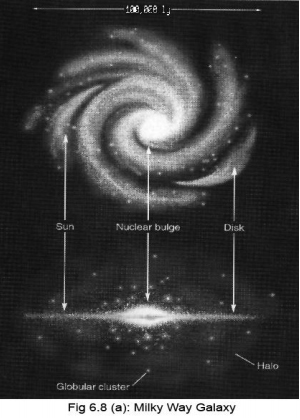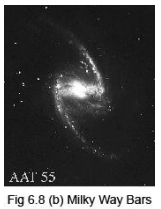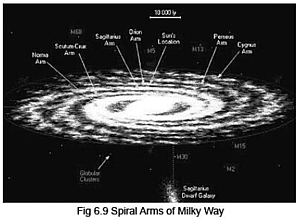Our Sun is just one star of Milky Way galaxy, which is visible from Earth as a hazy band of white light that is seen in the night sky. The disk of the Milky Way galaxy is approximately 100000 light years in diameter, about 250-300 light years in periphery, and about 1000 light years thick at the center (see fig 6.8). It is estimated to contain at least 200 billion and up to 400 billion stars (if small-mass stars predominate).

As a guide to the relative physical scale of the Milky Way, if it were reduced to 130 km in diameter, the solar system would be a mere 2 mm in width. Observations or Spitzer Space Telescope in 2005 suggested that the Milky Way is a barred spiral galaxy. As of 2006, The Milky Way's mass is thought to b about 5.8x 1011 solar masses (some estimates put the mass at 1.91x1012 solar masses). Most of the mass of the Galaxy is thought to be dark matter, forming a dark matter halo of estimated 600-3000 billion solar masses, which is spread out relatively evenly. The galactic disk bulges outward at the galactic center as shown in fig 6.8(a). The distance from the Sun to the galactic center is now estimated at 26000 + 1400 light years. The galactic center harbours a compact object of very large mass (named Sagitarius A*), strongly suspected to be a super massive black hole.
The evidence is mounting that Sag A* is indeed a black hole of 2-3 million times the mass of Sun, providing strong enough gravitational pull to keep the stars and gas in orbit. Most galaxies are believed to have a super massive black hole at their center. The fact that the Milky Way divides the night sky into two roughly equal hemispheres indicates that our solar system lies close to the galactic plane. The Galaxy's bar, figure 6.8(b), is thought to be about 27,000 light-years long, running through its center at a 44+10 degree angle to the line between the Sun and the center of the Galaxy. It is composed primarily of red stars, believed to be ancient.

Each spiral arm of Milky Way describes a logarithmic spiral (so do the arms of all spiral galaxies) with a pitch of approximately 12 degrees. There are believed to be four major arms which all start at the Galaxy's center. as shown in fig. 6.9. These arms are as follows: (1) 3-kpc and Perseus Arm (2) Norma and Cygnus Arm (3) Crux and Scutum Arm, and (4) Carina and Sagittarius Arm. There are at least two smaller arms or purrs, including Orion arm, which contains the solar system and the Sun. Outside of the major spiral arms is the Outer Ring, which consists of gas and stars torn from other galaxies billions of years ago.

As is typical for many galaxies, the distribution of mass in the Milky Way Galaxy is such that the orbital speed of most stars in the Galaxy does not depend strongly on its distance from the center. Away from the central bulge or outer rim, the typical stellar velocity is between 210 and 240 km/s. This is unlike in the solar system where different orbits are also expected to have significantly different velocities associated with them, and is one of the major pieces of evidence for the existence of dark matter.
The galactic disk is surrounded by a spheroid halo of old stars and globular clusters, of which 90% lie within 100000 light-years, suggesting a stellar halo diameter of 200000 light years However, a few globular clusters have been found further at more than 200000 light years away from the galactic center.
The Sun may be found close to the inner rim of the Orion Arm, at a hypothesized distance of 7.62 + 0.32 kpc from the galactic center. The distance between the local arm and the next arm out, the Perseus Arm is about 6500 light-years. The Sun, and thus the solar system, is found in what scientists call the galactic habitable zone. The apex of the Sun's way, or the solar apex, is the direction that the Sun travels through space in the Milky Way. The general direction of the Sun's galactic motion is towards the star Vega near the constellation of Hercules, at angle of 60 sky degrees to the direction of the Galactic center. The Sun's orbit around the Galaxy is expected to be roughly elliptical with the addition of perturbations due to the galactic spiral arms and non-uniform
mass distributions. In addition the Sun oscillates up and down relative to the galactic plane approximately 2.7 times per orbit. It takes the solar system about 225-250 million years to complete one orbit (a galactic year) and so it is thought to have completed about 20-25 orbits during its lifetime or 0.0008 orbits since the origin of humans. The orbit speed of the solar system is 220 km/s i.e. 1 light year in calendar 1400 years. Many astronomers believe the Milky Way is moving at approximately 600 km/s relative to the observed locations of other nearby galaxies. If the Galaxy is moving at 600 Km/s, Earth travels at 51.84 million km per day, or more than 18.9 billion km per year, about 4.5 times its closest distance from Pluto. The Galaxy is thought to be moving towards the constellation Hydra, and may some day become a close-knit member of the Virgo cluster of galaxies.
The Milky Way and the Andromeda Galaxy are a binary system of giant spiral galaxies. Together with their companion galaxies they form the local group, a group of some 50 closely bound galaxies. The Local Groups are part of the Virgo super cluster. The Milky Way is orbited by two smaller galaxies and a number of dwarf galaxies in the Local Group. The largest of these is the large Magellanic Cloud with a diameter of 20,000 light years. It has a close companion, the small Magellanic Cloud. Some of the dwarf galaxies orbiting the Milky Way are Canis Major Dwarf (the closest), Sagittarius Dwarf Elliptical Galaxy, Ursa Minor Dwarf, Sculptor Dwarf, Sextans Dwarf, Formax Dwarf, and Leo Dwarf. The smallest Milky Way dwarf galaxies are only 500 light- years in diameter. These include Carina Dwarf, Draco Dwarf, and Leo II Dwarf. There may still be undetected dwarf galaxies, which are dynamically bound to the Milky Way.
 Dr. N.L. Kachhara
Dr. N.L. Kachhara
